-
- Namibia Map
|
-
- Southern Africa Map
-
|
|
-
|
- latest picture:
January 21, 2015
|
-
-

|
-
-

|
-
-

|
-
082
A particularly impressive termite
- mound at Omuthiya along the main
- road B1 from Tsumeb to Ondangwa
- in the north, leaving
- our LandCruiser pretty small
|
-
083
The lady at the gasoline pump in
- Oshivelo and Emil in beaming
- competition. Nearby is the veterinary
- control gate (important for tourists mainly
- for meat products carried along)
|
-
084
There is an autumn feeling
- at the Mondjila Camping, 20 miles
- short of the Etosha Park entrance
- (Anderson Gate), which lies
- 11 miles south of Okaukuejo
|
-
|
-
-
-
-
 -
|
-
-

|
-
-
-
-

|
-
085
Over and over again we marvel
- about the perfection of the bird-nest of
- the southern masked weaver
- (Ploceus velatus)
|
-
086
A birds nest in the savannah where
- an entire colony of sociable weaver birds
- (Philetairus socius) lives and breeds,
- each pair having its own chamber …..
|
-
087
….. „What is going on down there?“
|
-
|
-
-

|
-
-

|
-
-
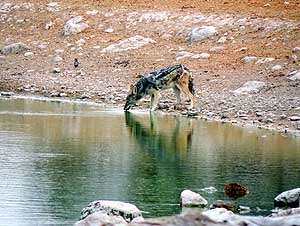
|
-
088
A warthog (Phacochoerus
- africanus) at the roadside. Outside the
- fence the grass seems to taste better
|
-
089
The Okaukuejo waterhole in the
- dry flat Etosha Park, where a few
- gazelles are gathering
|
-
090
A side-striped Jackal
- (Canis adustus) satisfies
- its thirst at a waterhole
|
-
|
-
-
-
-
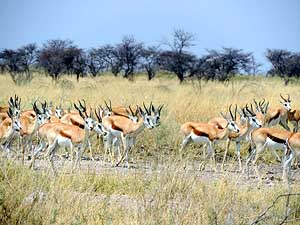 -
|
-
-

|
-
-
-
-

|
- After a downpour herds of graceful springboks (Antidorcas
marsupialis) roam along the roadside in the Etosha Park
|
-
091
|
-
092
|
-
093
|
-
|
-
-

|
-
-

|
-
-

|
-
094
An elephant (Loxodonta africana)
- trudging leisurely on its way. Unfortunately
- we see only two loners in the Etosha Park
- along the 90 miles long park road C38
- from Okaukuejo via Halali to Namutoni
|
-
095
A family of giraffes (Giraffa
- camelopardalis) strolls between
- bone-dry scrub
|
-
096
“Yet again tourists who are
- eager to take my picture!“
- A male lion (Panthera leo)
|
-
|
-
-

|
-
-

|
-
-

|
-
097
Black and white: A wildebeest
- (Connochaetes taurinus) and a termite
- mound grace the dry savannah of the
- eastern Etosha National Park
|
-
098
High yellow grass, dotted with
- acacias, is the typical picture of the
- savannah in the eastern part of
- the Etosha National Park
|
-
099
Unlimited freedom: An
- African ostrich (Struthio camelus)
- roams through the land
|
-
|
-
-

|
-
-

|
-
-

|
-
100
The waterhole – here in Okaukuejo
- – is for everyone!
|
-
101
Plains zebras
- (Equus quagga) on the tramp
|
-
102
"Yes, also our bottoms are striped!"
|
-
|
-
-

|
-
-

|
-
-

|
-
103
A lone rapier horned gemsbok
- (Oryx gazella) is resting in the rare shade
- in the eastern Etosha National Park
|
-
104
An African fish eagle (Haliaeetus
- vocifer) sits majestically on a tree stump
- and scans the environment
|
-
105
The huge ears of the female “greater”
- kudu (Tragelaphus strepsiceros) give this
- species of antelope its graceful look
|
-
|
-
-

|
-
-

|
-
-

|
-
106
One of the charming farms with
- huge estates, here along the B2 main road
- from Okahandja to Swakopmund
|
-
107
A short downpour conjures
- a beautiful double rainbow
|
-
108
The sun is setting behind the
- branches of an acacia tree
|
-
|
-
-

|
-
-

|
-
-

|
-
109
May be a little siesta? Emil makes
- himself comfortable at our camping spot
- at the Otjiwa Lodge, 22 miles south of
- Otjiwarongo …..
|
-
110
….. we love our quiet solitary
- campsite (Nr. 8) underneath acacia
- trees at the Otjiwa Lodge …..
|
-
111
….. where the spectacular
- sunset is nourishment for the soul
|
-
|
-
-

|
-
-

|
-
-

|
- Who has the best outlook? Birds on their vantage point:
|
-
112
The grey go-away-bird
- (Corythaixoides concolor)
- (Sachsenheim Guest Farm)
|
-
113
The pale chanting goshawk
- (Melierax canorus)
- (Etosha National Park)
|
-
114
The African red-eyed bulbul
- (Pycnonotus nigricans)
- (Elisenheim Guest Farm)
|
-
|
-
-

|
-
-
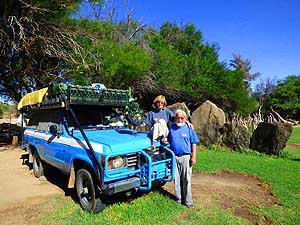
|
-
-

|
- We celebrate Christmas and New Year’s Eve 2014 at 100°F in the
shade at the Elisenheim Guest Farm 9 miles north of Windhoek
|
-
115
Our little Christmas celebration 2014
- “à deux” under an acacia tree: Our menu:
- Rib Eye Steak, Spaetzle and Red
- Cabbage. For desert: German
- Christmas fruit cake with rum
|
-
116
The three of us with our little tree
- on Christmas 2014. Despite of the
- oppressive heat, it spreads
- a little festive mood
|
-
117
New Year’s Eve together with
- our camping neighbors Gabi and Marcel
- from Switzerland. Our special treat:
- Swiss Chalet Fondue – a lovely end
- of our 30th anniversary year
|
-
|
-
-

|
-
-

|
-
-

|
-
118
“We also belong to your neighbor-
- hood!” Warthog families (Phacochoerus
- africanus) visit us now and then at the
- “Elisenheim Guestfarm”
|
-
119 A young bird is sitting patiently
- on a tree waiting to get fed
|
-
120 A chameleon moving
slowly
- forward. Chameleons are masters of
- camouflage to suit their surrounding
|
-
|
-
-
-
-
 -
|
-
-

|
-
-
-
-

|
-
121
No, this flying beetle is not going
- for our cheese triangle. It merely shows
- its impressive size
|
-
122
One needs to look very closely
- to discover such a delicate flower
- in the stony landscape
|
-
123 Wasps are working
busily on
- their nest built beneath a thatched roof
|
-
|
-
-

|
-
-

|
-
-

|
-
124 Emil’s strength: He is studying
- the map and the Namibia guide book
- to look for new destinations for our leg
- to the South African border, which we
- hadn’t visited already in May 1992
|
-
125 Peaceful morning mood at the
- Oanob Dam from our ‘sea view campsite’
- “Moyo”, 4 miles west of Rehoboth …..
|
-
126
….. where in the morning
- a group of ducks are lapping
|
-
|
-
-

|
-
-

|
-
-

|
-
127 About 15 miles into the gravel road
- C24 towards Klein Aub dark clouds
- announce an approaching thunderstorm
- – a reason more to avoid the next
- 375 miles of corrugated roads until Aub.
- We backtrack to the paved B1 .....
|
-
128 ….. and cross a lone ostrich
- (Struthio camelus). It is flightless, but
- is able to reach a speed of 43 mph
- despite its weight of 139 to 320 lb. …..
|
-
129 ….. then we drive
towards
- the blue sky and the tarmac road
|
-
|
-
-
-
-
 -
|
-
-

|
-
-
-
-

|
-
130
One of the 1’300 species of
- acacias with half moon like pulses
|
-
131
Buds of candelabra cacti
- flowers on the brink to open
|
-
132 The nostalgic
overloaded stall
- of the “Bastion Farmyard”, where we
- camped on a very clean ‘ensuite’ camp-
- site (each site has its own ablution)
|
-
|
-
-

|
-
-

|
-
-
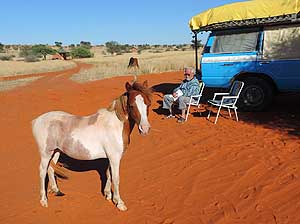
|
-
133 Our LandCruiser is driving on
- the D1268 (turn off C20) through a flat
- savannah to the red dunes at the edge
- of the Kalahari desert …..
|
-
134 ….. our idyllic “ensuite”-campsite
- between the small red chains of dunes at the
- “Bagatelle Kalahari Game Ranch” …..
|
-
135 ….. where early
morning a
- curious pony is paying us a visit
|
-
|
-
-
 -
|
-
-
-
-

|
-
-

|
-
136
Glorious red earth and a knobby
- acacia – a typical picture of the
- Namibian Kalahari Desert
|
-
137
View towards the east from a red
- dune over the vast yellow savannah of
- the Kalahari Desert at the Bagatelle
- Campground …..
|
-
138
….. and a nest of sociable weaver
- birds (Philetairus socius) between
- the red sand dunes
|
-
|
-
-

|
-
-

|
-
-

|
-
139 Who are the busy insects or
- worms digging up such lovely round
- patterns on the red earth?
|
-
140 In the cooler evening hours,
- millipedes (Diplopoda) crawl out of
- their shady tree trunk hideouts …..
|
-
141
….. in the morning the red
- desert sand is crisscrossed by
- hundreds of millipede’s traces
|
-
|
-
-

|
-
-

|
-
-

|
-
142 The yellow grass of
the savannah
- in the Kalahari is ablaze with the light
- of the setting sun
|
-
143 A thundering atmosphere mix with
- the red of the setting sun; mostly the rain
- doesn’t reach the soil because it
- evaporates already before
|
-
144 An irresistible
fascination: The
- setting sun transforms the clouds to
- a stunning range of colors
|
-
|
-
-
-
-
 -
|
-
-

|
-
-
-
-
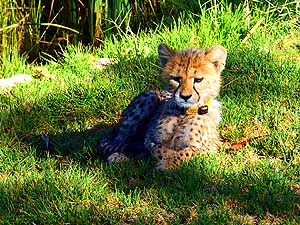
|
-
145
Who is greeting us joyfully when
- we park at the “Lapa Lange Game Lodge”?
- Two playful 10 weeks old Cheetah babies
- (Acinonyx jubatus) that make themselves
- comfortable straight away below our
- LandCruiser. Is there a better place?
|
-
146
Capturing a precious moment:
- A playful cheetah baby with Liliana.
- It likes to be caressed and purrs
- contently like a “common” cat
|
-
147 So cute, but already
sneaky:
- In an unobserved moment, it chews
- on our shoes. It cavorts with the others
- and makes the first tries climbing trees
|
-
|
-
-

|
-
-

|
-
-

|
-
148 Two white rhinoceroses
- (Eratotherium simum) are heading
- determined to the waterhole of the “Lapa
- Lange Game Lodge” in the Hardap region,
- 170 miles southeast of Windhoek …..
|
-
149 ….. later on they graze peacefully
- around our LandCruiser on the camping
- ground until a guard chases
- them away at 10pm
|
-
150 A small herd of common
elands
- (Taurotragus oryx) is gathering in front
- of the waterhole of the “Lapa Lange
- Game Lodge”. They are good sprinters
- and are able to jump up to 6½ ft.
|
-
|
-
-

|
-
-

|
-
-

|
-
151 Two Kudus (Tragelaphus
- strepsiceros) are peeking curiously
- across the electric fence to our camping
- spot at the “Lapa Lange Game Lodge”
|
-
152 “Aren’t we cute when standing up
- on our hind legs?” Meerkats (Suricata
- suricatta) live in large harmonious groups,
- eat insects and worms, but also scorpions
|
-
153 A rock badger (Procavia
- capensis) looks like glued onto the rock.
- But when it moves on, it runs with a
- remarkable speed to the next cover
|
-
|
-
-

|
-
-

|
-
-

|
-
154 Our LandCruiser climbs the good
- gravel road to the extinct Brukkaros
- Volcano (5’220 ft.), situated west of B1
- between Mariental and Keetmanshoop
|
-
155 The crater is 2km wide
and was
- formed some 80 million years ago. It
- dominates the skyline between
- Mariental and Keetmanshoop
|
-
156 A ‘nightmare’ for our
senior,
- 33-years old Landcruiser! The corrugated
- road to the “Quivertree Forest Rest
- Camp”, about 8½ miles northeast of
- Keetmanshoop along road C17
|
-
|
-
-

|
-
-

|
-
-

|
-
157 The three of us, surrounded by
- Kokerboom trees – called also Quiver
- Trees (Aloe dichotoma) that only grow
- in the south of Namibia and the northern
- Cape region of South Africa. They
- remind us to the dragon trees (Dracaena
- cinnabari) on Socotra in
Yemen
|
-
158 The quiver trees belong to the
- Aloe family (Aloe dichotoma) and can
- grow up to 26 ft.. Its name derives
- from the Bushmen who used the hollowed
- out branches as containers for arrows
|
-
159 Our campsite at the “Quivertree
- Forest Rest Camp” where birds and
- rock badgers are our only neighbors
|
-
|
-
-
-
-
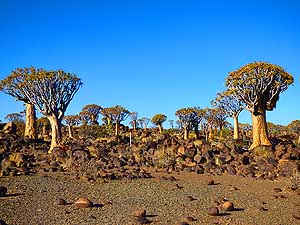 -
|
-
-

|
-
-
-
-
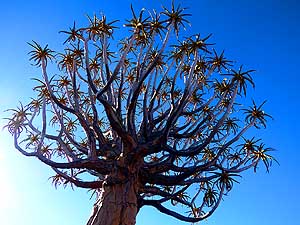
|
-
160
|
-
161
|
-
162
|
- Be it a forest of quiver trees or just a single one in the warm
light of the setting sun with its unique, up to 13 inches long leaves
–
- all of them fascinate us
|
-
|
-
-
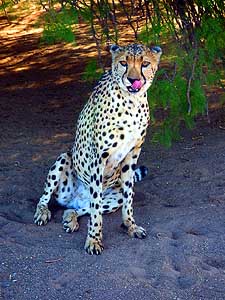
|
-
-
-
-

|
-
-

|
-
163
|
-
164
|
-
165 A beautifully colored
Southern
- Rock Agama (Agama atra), a species
- of lizard that lives in Southwestern
- Africa and measures about 10"
|
- Feeding of the full grown cheetahs at the enclosure of the
“Quivertree Forest Rest Camp”.
- Cheetahs (Acinonyx jubatus) can reach an age of 15 years in
liberty and can speed
- up to 70 mph (weight 46 to 159 lb.)
|
-
|
-
|
-
-
-
-
 -
|
-
-

|
-
-
-
-

|
-
166
Liliana is taking in the bizarre
- rock formations in the labyrinth of the
- “Giants’ Playground” – the balancing
- stones. It belongs to the “Quivertree
- Forest Rest Camp” and is only
- 3 miles away (to the east) …..
|
-
167
….. a fantastic example of balancing
- rocks at the “Giants’ Playground” …..
|
-
168 ….. the bizarre
natural rock
- garden has a size of 3.86 mi² and
- is formed by volcanic eruptions
|
-
|
-
-
-
-
 -
|
-
-

|
-
-
-
-

|
-
169
Our camping spot under the only
- acacia at the “White House Camping”
- near Grünau along the B1, where in the
- evening we get the visit of a scorpion,
- apparently a sign that rain is imminent …..
|
-
170
….. view to the northeast from
- the “White House Camping” …..
|
-
171 ….. and to the hill
from where
- we are watched for quite some time
- by two curious goats
|
-
|
-
-
-
-
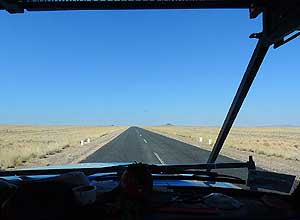 -
|
-
-

|
-
-
-
-

|
-
172
We continue to follow the dead
- straight highway B1 through yellow
- savannah towards the Namibian-
- South African border posts of
- Noordoewer/Vioolsdrif. Thus we have
- driven the whole B1 from
Angola
|
-
173
At the Namibian border post of
- Noordoewer at the Oranje River, we
- reach one of the Namibian vineyard
- cultivations. Apart from Maltahöhe in the
- center, most others are situated in
- Namibia’s North (Otavi, Omaruru)
|
-
174 Idyllic view over the
Orange
- border river from the Amanzi Camp
- in Noordoewer. It is January 21st, 2015
- – the very hot day (more than 104°F)
- before we cross the border
- (the 505th!)
to South Africa
|
-
|
- Back to the previous Namibia page: Namibia Part 1
–
from Walvis Bay to Windhoek
|
-
- The African trip
2013-15:
- CapeVerde: Santiago/Praia
part 1 – November18th to December 13th, 2013
- CapeVerde: Fogo
– Dezember13th to 23rd, 2013
- CapeVerde: Brava
– December 23rd to 26th, 2013
- Cape Verde: Santiago/Praia
part 2 – December 26th, 2013 to February 28th, 2014
- Cape Verde: São Nicolau – February
28th to March 13th, 2014
- Cape Verde: São Vicente/Mindelo part 1
– March 13th to 20th, 2014
- Cape
Verde: Santo Antão/Eastern side part 1 –
March 20th to April 7th, 2014
- Cape
Verde: Santo Antão/Western side part 2 –
April 7th to 10th, 2014
- Cape
Verde: São Vicente/Mindelo part 2 –
April 10th to 29th, 2014
-
Namibia Part 1 –
from Walvis Bay to Windhoek
- Angola Part 1
–
September 26th to October 4th, 2014
- Angola Part 2 –
October 4th to 22nd, 2014
|
![]()































































































